VP10 wheeled armored personnel carrier with a CS / AA5 combat module (China)
A prospective model of armored vehicles with new weapons was presented by China North Industries Group Corporation (CNGC or NORINCO). Various enterprises from this organization are engaged in the creation of certain types of equipment of various classes and purposes. This time, the result of this collaboration was the appearance of a wheeled armored personnel carrier with a combat module of a new type. Reportedly, the armored vehicle presented in Zhuhai is intended for export deliveries. Given the declared characteristics and capabilities, such equipment can really win its share of the arms market.
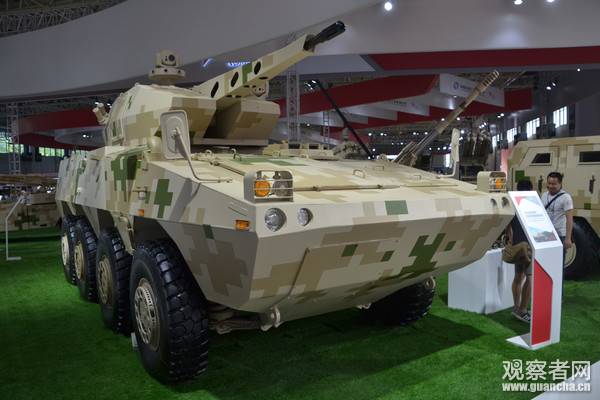
General view of the armored vehicle
The VP10 chassis was chosen as the basis for the new export sample. The existence of this car became known last year. The project of wheeled armored vehicles was developed by one of the enterprises from the CNGC for the subsequent proposal to the military department. Based on the results of inspections and tests, the People’s Liberation Army of China chose another model of armored vehicles, which is why the VP10 project was left without real prospects. As it became clear now, it was further developed with a view to launching it on the international market.
The VP10 armored personnel carrier is a wheeled combat vehicle built with the active use of existing ideas and solutions. The general features of the architecture of the machine coincide with those used in other modern projects of similar technology, including foreign ones. Such an approach should ensure the solution of all the main tasks and bring the characteristics of the equipment to the required level. In addition, it becomes possible to use a single chassis as the basis for several samples of armored vehicles for various purposes.
Like other modern armored personnel carriers developed in recent years, the Chinese VP10 has a layout with a front engine compartment and aft troop compartment. In addition, based on their own and foreign experience, Chinese designers have created an armored corps, able to protect the crew and internal units of the machine from various threats, including small-caliber artillery. It should be noted that lately the VP10 has undergone some changes. The sample presented at the recent exhibition, looks different from the previously known prototype.
The current version of the project uses an armored body with a frontal part of a wedge-shaped profile formed by several armor plates. The top sheet is located at a large angle to the vertical and is responsible for protecting the crew and the engine. In addition, it has hatches for access to the engine compartment. When reworking the project, CNGC engineers changed the proportions of the onboard housing niches. At the same time, the existing slope of the upper armor plates was preserved. From the previous version of the project, the sloped stern sheet and some other aggregates were also borrowed.
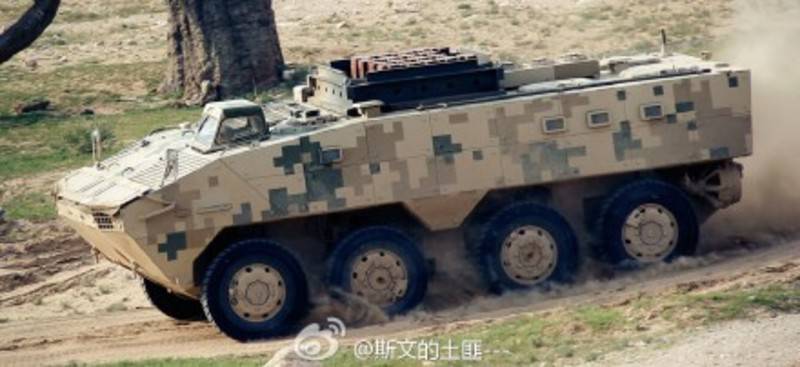
The VP10 armored personnel carrier during the tests, photo 2015
The layout of the machine is standard for such equipment. In front of the hull, at the starboard side, the engine and part of the transmission devices are placed. To the left of the engine is the control compartment with the driver's workplace. All other volumes are given for the installation of crew and landing places. This arrangement of the habitable compartment makes it possible to use the stern ramp of the assault force, which to a certain extent improves the protection of the soldiers during the battle.
According to previously published data, the VP10 BTR is equipped with a hp 360 diesel engine. High mobility and maneuverability are provided with all-wheel drive four-axle chassis. The crew of an armored personnel carrier, depending on the modification and configuration, consists of two or more people. In the large troop compartment can be placed up to 12 seats. The latter are placed at the sides of the hull. It is noteworthy that in the latest version of the project there are no viewing devices in the sides of the troop compartment. For access to the habitable compartments and their escape, the hull has several hatches in the roof, as well as a folding stern ramp. In case of failure of mechanical drives, the ramp is equipped with an additional door.
The chassis length reaches 6,9 m, width - 2,7 m, height (on the roof of the hull) - 2,1 m. The combat weight without weapons and special systems was set at 12,5 tons. On a highway, a car can reach speeds up to 105 km / h using two jet propulsion in the stern, - up to 8 km / h. Power reserve - 800 km. Chassis allows you to overcome various obstacles.
In the basic configuration, the Chinese armored personnel carrier is equipped with a combat module with an 30-mm automatic cannon and an 7,62-mm paired machine gun. Presented at the Airshow China 2016 new version of the combat vehicle is characterized by the presence of other weapons and related systems. In order to develop the existing platform and attract new potential buyers, CNGC has developed and introduced the CS / AA5 combat module, equipped with an 40 mm automatic cannon.
The CS / AA5 product is a relatively large turret with all the necessary equipment and weapons, designed for installation on existing and prospective models of armored vehicles. In accordance with the current trends in the development of such systems, the combat module of a new type is made uninhabitable and remotely controlled. The product is proposed to be mounted on the roof of the base machine body and connected to some equipment installed inside it. This allows you to solve existing problems, but do not occupy volumes within the protected space.
All major components and assemblies of the combat module are placed inside an armored body of complex shape, providing protection from external influences, including damage weapons the adversary. The body has a divided frontal part of a wedge-shaped form, between the individual blocks of which there is a swinging implement unit. The sides of the hull are made in the form of blocks of two parts of the corresponding shapes and sizes: the lower ones are mounted with a camber outwards, the upper ones are inclined inward. The combat module feed also has two side wedge-shaped protrusions. The main large part of the roof is placed horizontally. Also next to it are smaller sheets needed to install these or other devices. The recognizable appearance of the tower is also associated with the use of a casing of a complex tool. In the back of the casing, made in the shape of a truncated pyramid, openings are provided for air access and better cooling of the trunk. On both sides and aft of the hull, hatches are provided for access to the inside of the combat module.
The central part of the combat module is given under the placement of the rocking installation with a new type of weapon. The CS / AA5 module uses an 40-mm automatic cannon using the original ammunition architecture. The main feature of this weapon is the use of so-called. telescopic shells. From ordinary shots such ammunition differ in the placement of the projectile. The latter is completely inside the liner. The propellant charge, in turn, fills all free volumes of the liner. Such a shot architecture has several advantages over traditional systems. First of all, the size of the ammunition decreases, which allows to increase the size of the transported ammunition. At the same time, there is some loss in the energy parameters.
The type of automatics of the new gun was not specified. In this case, the developers note that the weapon can change the rate of fire in accordance with the instructions of the operator. The rate of fire varies from 100 to 200 shots per minute. Depending on the type of ammunition used, the initial velocity of the projectile may exceed 1400 m / s, which allows you to fire targets at ranges up to several kilometers. The proposed nomenclature of ammunition allows for the effective attack of manpower, buildings and armored vehicles of the enemy. It also provides a certain advantage in firepower over other models of armored vehicles armed with 30-mm automatic guns.
At the Airshow China 2016, for the first time, two types of ammunition for the new 40-mm gun were shown. CS / BTE3 is a telescopic shot with a high-explosive fragmentation projectile. The initial speed of the latter reaches 1000 m / s. To combat the enemy's armored vehicles, a sub-caliber CS / BAA3 armor-piercing projectile, accelerated to 1450 m / s, is proposed. An armor-piercing shot, allegedly, shows fairly high performance. When fired from a distance of 1000 m, a CS / BAA3 projectile punches up to 130 mm of homogeneous armor. Also mentioned is the possibility of breaking through to 160 mm of armor in other conditions.
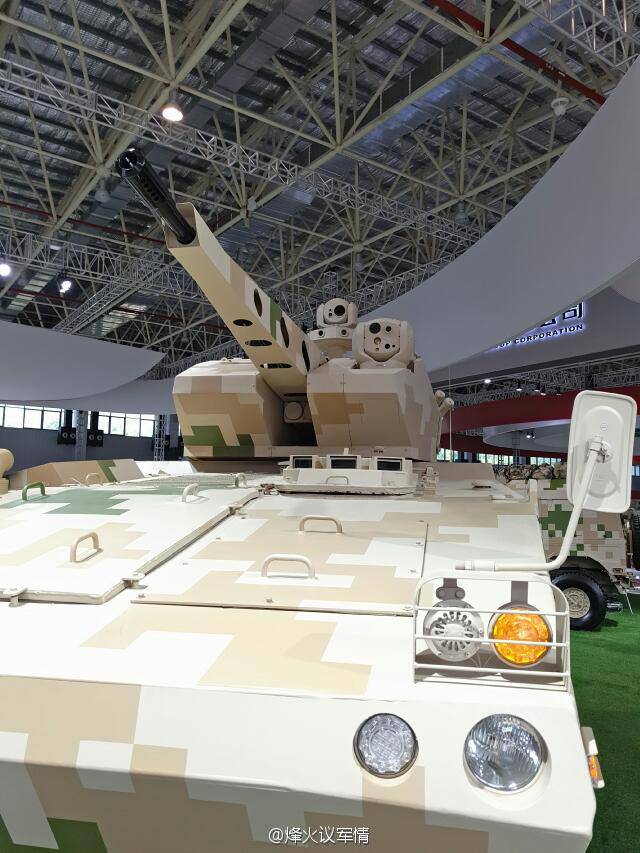
The forehead and the tower
Chinese-made telescopic munitions have a similar architecture, but differ in some design features. Both products have a projectile with a head equipped with a “payload” in the form of an armor-piercing core for CS / BAA3 or an explosive charge of a CS / BTE3. To the tail of the main unit of the projectile mounted cylindrical shank-equipped with feathers. As follows from the published data, the length of the projectile is slightly less than the length of the liner, because of which it occupies most of the internal volume of the latter.
As part of the exhibition, CNGC Corporation presented several split models of promising shells, as well as a fragment of armor, showing the results of the use of new weapons. The shown models were regular shots without a propellant charge, in the case of which there was a window to demonstrate the internal volume and the projectile placed there. In addition, similar cuts existed on the shells themselves: the hole in the high-explosive fragmentation allowed to consider the imitation of the explosive charge, and in the case of an armor-piercing one could see the placement and design of the core.
To demonstrate the capabilities of an armor-piercing shot on one stand with models of ammunition, there were fragments of armor subjected to shelling during tests. After the shot, the armor plate was cut in the plane of the passage of the core, so that it was possible to consider the consequences of penetration in detail. The result of the penetration of the striking element was the formation of a through channel with characteristic uneven walls and a changing cross-section with enlarged "funnels" at the inlet and outlet.
One of the main advantages of artillery guns with telescopic ammunition is the possibility of a significant increase in ammunition. However, the size of the portable ammunition of the CS / AA5 combat module was not announced. Apparently, we are talking about several hundred shells of two types.
As an auxiliary weapon, the CS / AA5 combat module carries eight smoke grenade launchers. Two such devices are mounted in the stern of the sides and on the stern sheets of the hull. A shot of smoke grenades is carried out in the front hemisphere of the turret: fodder grenade launchers send ammunition forward and upward, airborne - upwards and to the sides.
For observation of the terrain and guidance of weapons, the combat module of a new type received an advanced optical-electronic equipment complex. The main means of monitoring and controlling weapons is an opto-electronic unit mounted on a U-shaped support to the left of the gun. The characteristic view of the front wall of this unit indicates the presence of a standard set of equipment for such systems as part of a video camera and thermal imager, as well as a laser range finder. The front block of observation tools can rotate in the horizontal and vertical planes, allowing you to inspect the terrain or choose a target, putting weapons on it.
In order to enhance the crew’s ability to monitor and detect targets, the CS / AA5 combat module is equipped with a second set of optical equipment. In the stern of the roof of the module, on the longitudinal axis, there is a support-mast on which two devices with optics are placed. The bottom has a cylindrical body of small height, around the perimeter of which are the lenses of optical instruments. On the top cover of this device is placed another unit of opto-electronic equipment, similar to that installed next to the gun. Such a layout and composition of the second optical unit allows the crew to monitor the entire surrounding area and detect threats in time, receiving the necessary time to respond to them.
Two sets of optical devices are intended for simultaneous use by the commander and gunner of an armored vehicle. The video signal from the camera or thermal imager, as well as information from the laser range finder or other devices are displayed on the control panel monitors. In addition to monitors, crews' workplaces with control units are installed to monitor the operation of the combat module and its armament. From the point of view of the main features of the application, the CS / AA5 product should not seriously differ from other modern systems of this class.
According to reports, the new Chinese wheeled armored personnel carrier with a promising combat module CS / AA5 is intended for deliveries to foreign customers. The stated characteristics of the machine suggest that it may indeed be of great interest to the armies of some foreign countries. Based on the ideas and solutions characteristic of modern armored vehicles of its class, the VP10 has sufficiently high characteristics, and the combat capabilities of the vehicle are brought to a new level with the help of the CS / AA5 module with an 40-mm automatic cannon.
The perspective automatic weapon with telescopic shells differs from the samples widespread now in the increased caliber and, as a result, in higher characteristics. The presence in the ammunition of high-explosive and armor-piercing sub-caliber shells allows the combat vehicle to fight with a variety of goals characteristic of modern armed conflicts. With the help of high-explosive fragmentation shells, it is possible to defeat manpower, unprotected equipment and various structures or fortifications. Also with limited effectiveness, the 40-mm gun can be used against enemy aircraft moving at low speed at low altitude.
Of great interest are the claimed characteristics of the armor penetration of the CS / BTE3 shell. According to official figures, such a shot at a distance of 1 km is capable of breaking a through hole in a 130-mm armor plate. Thanks to this, an armored personnel carrier with new weapons can, firing from safe distances, withdraw and build or destroy other equipment of its class. Moreover, there is some potential in the fight against tanks outdated models. Such armored vehicles are still in service with some armies and can be used in battles. The CS / AA5 combat module, in turn, is a good response to such threats.
It should be noted that with all its advantages in the form of increased ammunition, etc., guns with telescopic projectiles have some drawbacks. Thus, such systems lose the energy of ammunition to weapons of the same caliber, built according to traditional schemes. In addition, the characteristics of the filing of the projectile in the barrel and other design features lead to a reduction in the resource of the gun in comparison with the "ordinary" counterparts. As follows from the published materials, the problem of reducing the energy of the projectile was solved by Chinese gunsmiths by increasing the caliber. The use of 40-mm projectiles allows not only to compensate for the possible loss of performance in comparison with guns of the 30 caliber mm, but also to provide certain advantages over them.
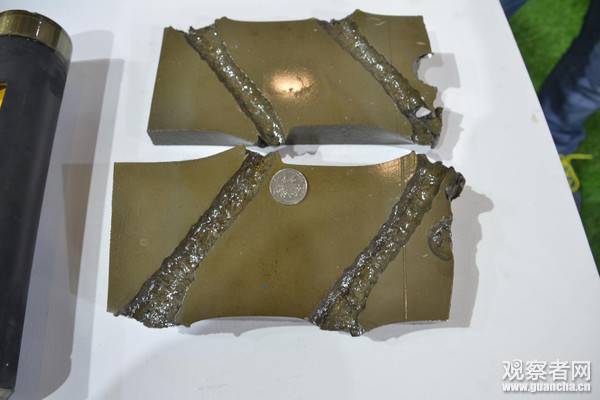
Consequences of the shot armor-piercing projectile
Thus, at the moment, in light of the published information, the VP10 wheeled armored personnel carrier with the CS / AA5 combat module looks an interesting and promising development. Already known chassis, corresponding to modern views on such equipment, should have sufficiently high characteristics of mobility, protection and payload, and a promising combat module, first shown at a recent exhibition, should give the car high firepower and appropriate combat effectiveness. Perhaps the new Chinese armored vehicle has certain disadvantages, however, the company-developer, for obvious reasons, is in no hurry to disclose the existing problems, and even more so, to focus on them.
As potential customers of the export armored personnel carrier, various states of Asia and Africa should be considered, first of all, those who already have experience of cooperation with the Chinese defense industry. China in general, and CNGC in particular, have already managed to find buyers for a significant number of combat vehicles, originally created for deliveries to foreign countries. The new armored personnel carrier with the 40-mm gun has every chance to fill this list. An armored vehicle with a relatively powerful weapon capable of hitting various targets, including tanks of outdated models, may be of interest to many states. An additional competitive advantage of the Chinese sample can be a relatively low cost.
To date, China North Industries Group Corporation has only managed to present its latest development to the general public, professionals and potential customers. In this regard, orders for mass production and supply of such equipment have not yet been received. However, if the demonstration during the Airshow China 2016 exhibition fulfilled the tasks assigned to it, then in the near future the manufacturing company should receive the first purchase offers of an interesting sample. Firm contracts for the supply of VP10 armored personnel carriers with combat modules CS / AA5, as always happens in such cases, can appear no earlier than a few months after the first demonstration of equipment. In the meantime, it remains only to build forecasts and try to predict whether the new Chinese armored vehicles will become the subject of contracts and who exactly will want to buy it.
On the materials of the sites:
http://guancha.cn/
http://defence-blog.com/
http://army-guide.com/
http://gurkhan.blogspot.ru/
http://snafu-solomon.blogspot.ru/
http://imp-navigator.livejournal.com/
http://bmpd.livejournal.com/
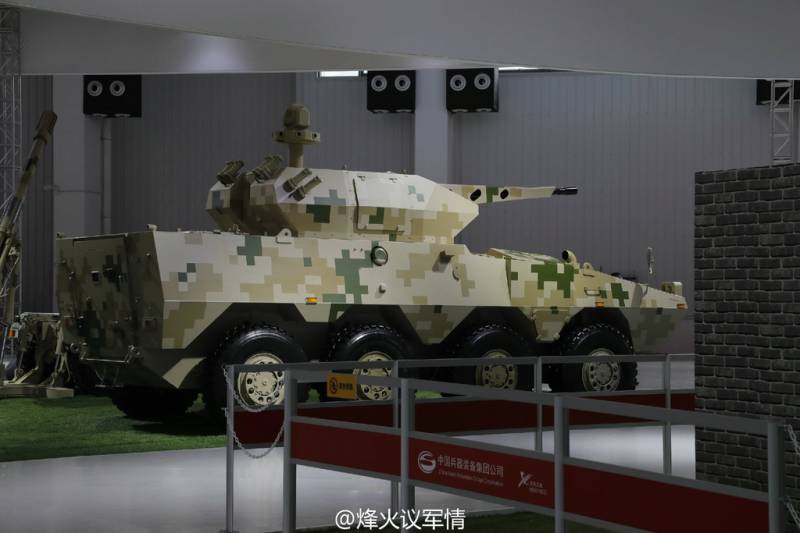
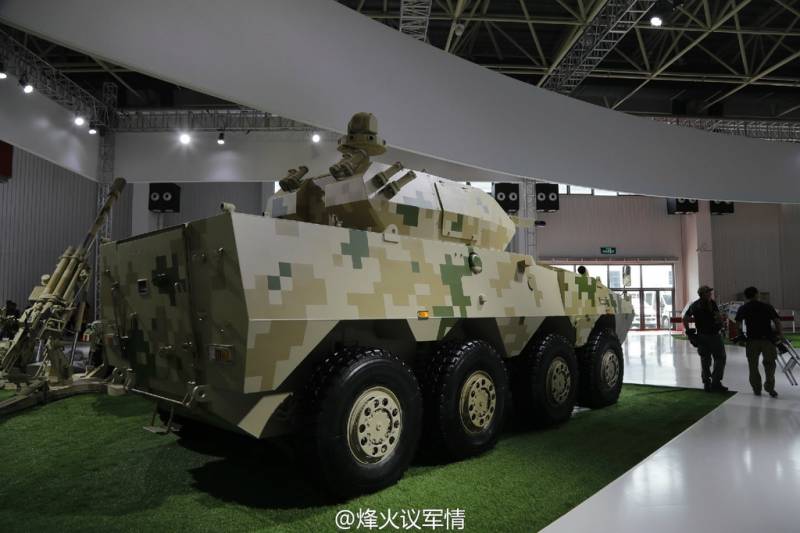
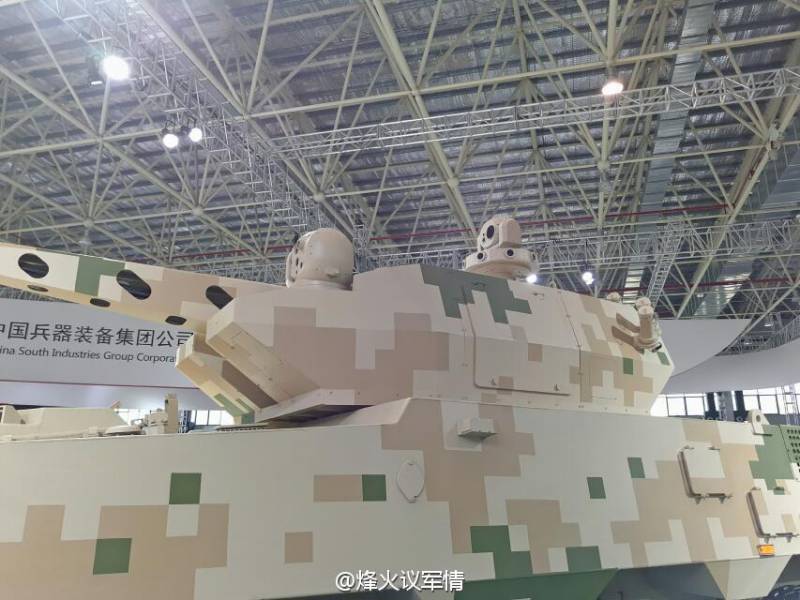
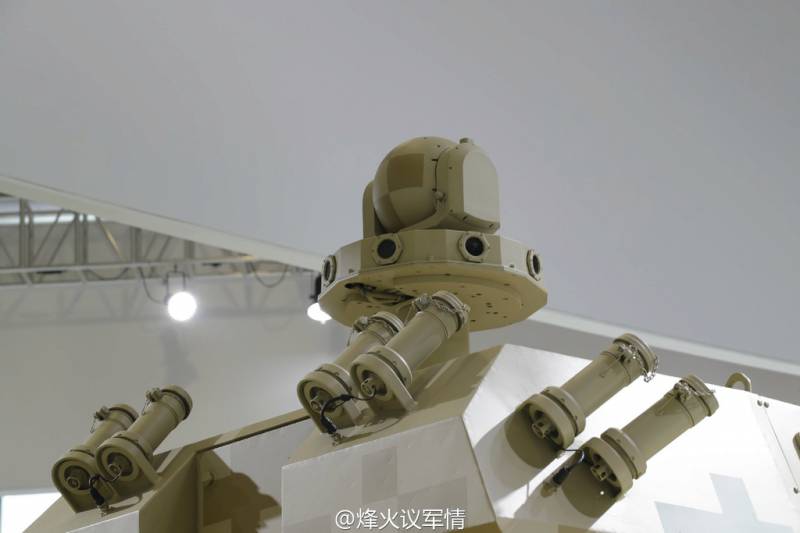
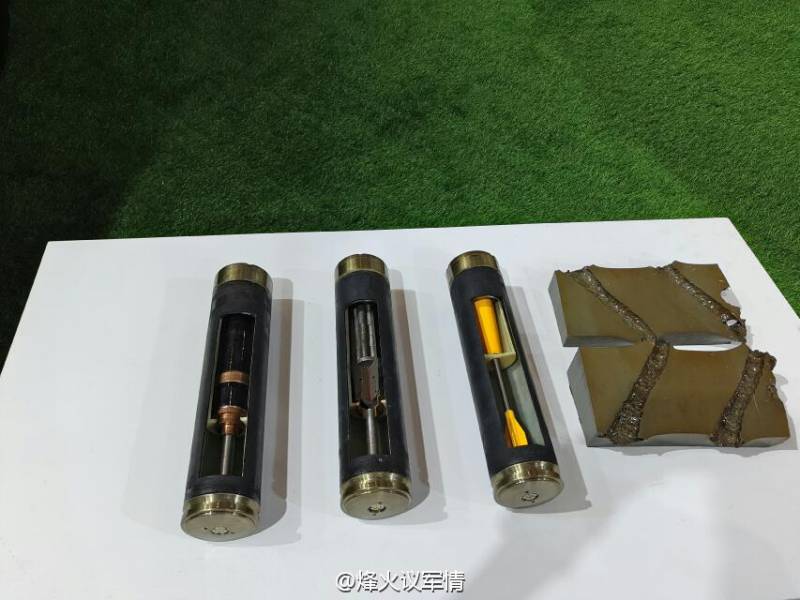
Information